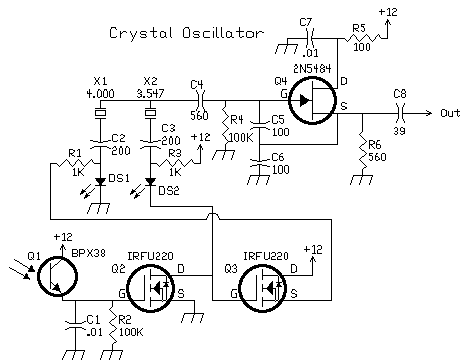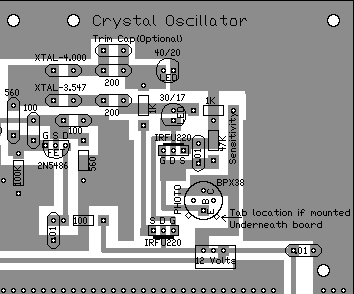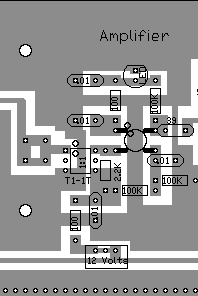


The oscillator frequency is switched with the crystal filters to maintain a 455 kHz output for the 455 kHz IF strip. If the 3.547 MHz crystal filter is on, the BPX38 does not receive any infra-red energy, and is turned off. When the BPX38 (Q1) is off, no current flows through Q1, the 100K resistor (R2), brings the gate voltage of Q2 to zero, turning off Q2. 12 Volts flows through a 1K resistor (R3), through the 3.547 crystal LED (DS2), which brings the gate of Q3 to 12 volts, which turns on Q3. No current is flowing, since the Gate of Q3 is very high impedance, so the 3.547 LED (DS2) is off. But Q3 is turned on, which supplies 12 Volts to the 4.000 LED (DS1) through a 1K resistor (R1), which yields an oscillator frequency of 4.000 MHz. If the 4.000 MHz crystal filter is on, the IRED emitter at the filter shines infra-red light on the BPX38, which turns the phototransistor on. When the BPX38 is on, the Gate of Q2 raises to 12 volts, turning on Q2. The source of Q2 grounded, so when Q2 is turned on, the Gate of Q3 is grounded, turning off Q3, which turns off the 4.000 LED (DS1). This also grounds the cathode of the 3.547 LED (DS2) and 12 Volts flows through the 3.547 MHz LED ((DS2), turning on the oscillator to 3.547 MHz. Addtional Circuit InformationThe 200pf capacitors (C2 & C3) are used to fine tune the frequency of the crystals, so that the BFO is the same pitch for both sets of frequencies. The 200pf capacitors get the pitch very close, but not exactly, so the BFO tuning capacitor is adjusted to maintain proper pitch when switching between the crystal filters. Capacitors may be paralleled across C2 and C3, or lowered in value, to set the pitches exactly. If the optional one-crystal filters are added at the oscillator amplifier output, the 200pf capacitors help tune the crystals so that maximum energy passes through the one crystal filter. The brightness of the LEDs at the mixer show osccillator output, so they can be used as an indicator to find the right values for C2 and C3 for maximum output through the one-crystal filters. The one-crystal filters remove the second harmonic content of the oscillator and provide a very clean signal to the second mixer. The filters also remove phase noise from the output, but the one-crystal filters won't improve receiver performance unless an extremely pure phase noise VFO is also used. The passband of the one crystal filter is lower than the crystal oscillator's frequency, so the crystals must be padded to lower the frequency to fit through the filter with as little attenuation as possible. Padding the stock values is best for matching the BFO frequency, to keep maximum output through the one crystal filter. Super-bright LEDs will work in the circuit at the expense of output. The three volt forward voltage drop of the Super-brights lowers the output. The lower the forward voltage drop of the LEDs, the higher the output. Changing out the LEDs with silicon diodes (1N914's) would raise the output over the LEDs, since the forward voltage drop for the 1N914's is only .7 volts.  The output of the oscillator/amplifier chain, with the LEDs in place, is optimum with about 5-6 volts peak-to-peak into the mixer. The brightness of the second mixer LEDs are a direct indication of oscillator drive.  The four unlabeled holes to the left of the amplifier is where the one-crystal filters are added. The parallel traces between the holes need to be cut if the crystals are added. |
Send E-Mail || Amateur Radio Receivers || Electroluminescent Receiver ||
Infrared Switching Home Page
